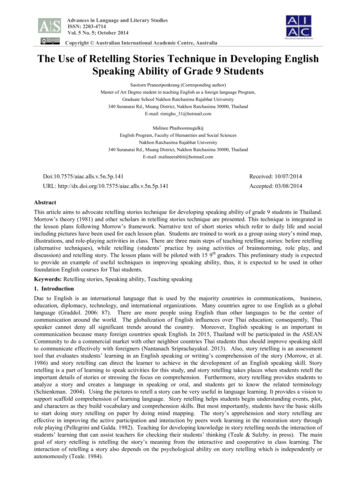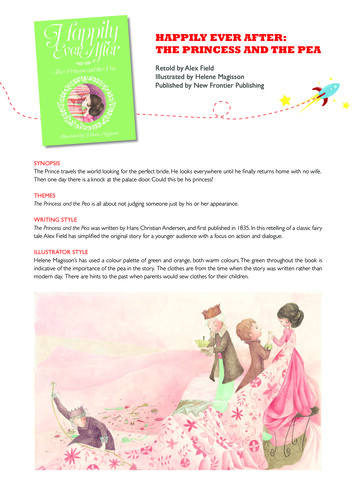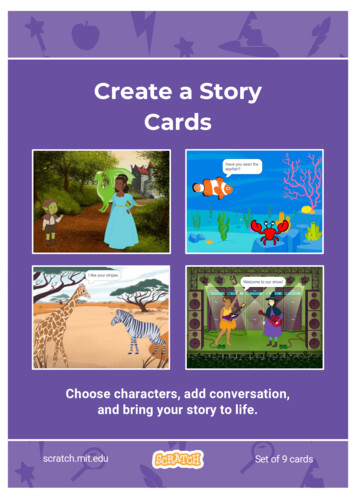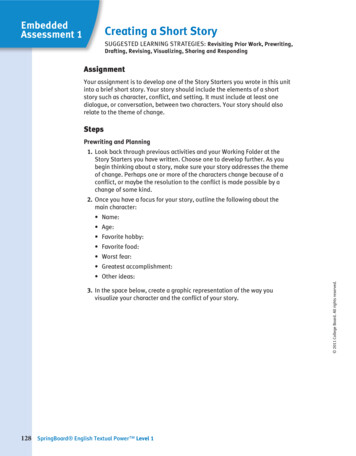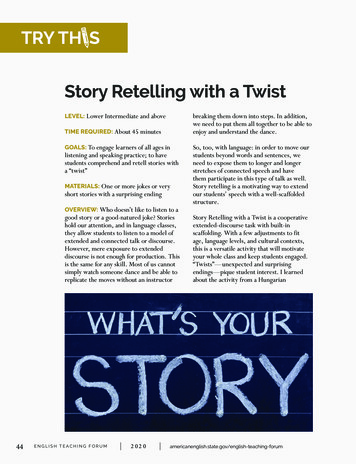
Transcription
TRY THISStory Retelling with a TwistLEVEL: Lower Intermediate and abovebreaking them down into steps. In addition,we need to put them all together to be able toenjoy and understand the dance.TIME REQUIRED: About 45 minutesGOALS: To engage learners of all ages inlistening and speaking practice; to havestudents comprehend and retell stories witha “twist”MATERIALS: One or more jokes or veryshort stories with a surprising endingOVERVIEW: Who doesn’t like to listen to agood story or a good-natured joke? Storieshold our attention, and in language classes,they allow students to listen to a model ofextended and connected talk or discourse.However, mere exposure to extendeddiscourse is not enough for production. Thisis the same for any skill. Most of us cannotsimply watch someone dance and be able toreplicate the moves without an instructor44ENGLISH TEACHING FORUM2 02 0So, too, with language: in order to move ourstudents beyond words and sentences, weneed to expose them to longer and longerstretches of connected speech and havethem participate in this type of talk as well.Story retelling is a motivating way to extendour students’ speech with a well-scaffoldedstructure.Story Retelling with a Twist is a cooperativeextended-discourse task with built-inscaffolding. With a few adjustments to fitage, language levels, and cultural contexts,this is a versatile activity that will motivateyour whole class and keep students engaged.“Twists”—unexpected and surprisingendings—pique student interest. I learnedabout the activity from a g-forum
colleague while working as an English as aforeign language (EFL) teacher in Debrecen,Hungary. I have also used it with Hungarianuniversity students, with Latin Americanand Polish adult immigrants in communitybased programs in the United States, andwith Mexican children in private elementaryschools in central Mexico.PREPARATION:1.Find a very short story or joke with atwist. Make sure the story or joke isat your students’ listening level. A fewexamples are provided at the end ofthis article; you can adapt them if youneed to.2 . Practice reading the story or joke so thatyou can read it fluently, with the correcttiming for the twist at the end.3 . Identify potentially troubling grammarstructures or new vocabulary. Decidehow you will present these, whetherwith a quick drawing, gestures, thepresentation of objects, or anothermethod that you feel comfortable with.Keep in mind that the activity works bestif students are already familiar with thegrammar and vocabulary in the story.PROCEDURE:1.Tell students, “I am going to tell youa story.” Then add, “You must listencarefully. After I finish telling the story,you will tell the same story yourselves.”2 . Divide the class into groups of no largerthan four or five students. If it is notpossible to move desks or for groups togo to another place in the room, makesure the group members are sitting nextto one another.3 . Choose one person from each group tostep outside the classroom. You coulddo this by specifying the person withthe longest or shortest hair, the onewhose birthday is next, or some otherdistinguishing detail. These students willbe the “storytellers.” If it is not possiblefor students to go outside the room, givethe storytellers a short task to completeas a group, such as a crossword puzzle ora word search.4 . After these students—the storytellers—are out of listening range, teach orreview key vocabulary (and grammar, ifnecessary). Be sure to leave these wordsvisible for easy reference during thegroup retelling. Again, you should tryto keep new vocabulary and grammarpoints to a minimum.5 . Read the story once at a slow place,and then read it again normally. It isimportant to read the story to makesure you tell it in exactly the sameway each time. You may want toread it a third time if students insist.You may also want to ask a fewcomprehension questions. I don’tallow my students to take notes inthis activity because I want them tofocus on listening only.6 . Call the storytellers back into the roomand have them return to their groups.7. The group members tell the storyto their storyteller once or twice, asneeded. Do not give them a copy ofthe story. Emphasize that everyone isresponsible for telling the story to thestoryteller in the group. To make surethis happens, you might want to giveeach group a talking piece that ispassed around the group. No one canhave another turn until each memberhas contributed something. If someoneneeds assistance, though, other groupmembers may help.8 . Send all the storytellers out of the roomagain except for one, who will stand orsit in the front of the room.9 . Have this first storyteller retell the storyor joke to the orum2020ENGLISH TEACHING FORUM45
1 0 . Call the next storyteller into the roomand repeat Step 9 until each storytellerhas retold the story.1 1 . Have the class clap or snap after eachretelling. You can have students who arelistening let each storyteller know whathe or she left out, as well as some thingsthe storyteller did well.1 2 . An optional step is to give each groupa few minutes to choose the beststoryteller or storytelling group and toprovide reasons for the choice.VARIATIONS1.For large classes, after the storytellershave heard the story from their groups,have all the storytellers stay in the roombut move to a different group to retellthe story. You can repeat this processonce.2 . At the beginning of the activity, dividethe class into three groups. In thisversion, everyone stays in the room. Asyou tell the story, have one group writedown nouns in the story, another groupjot down verbs, and the third groupwrite adjectives. Then allow members ofthe same group to compare notes beforeputting members from each grammargroup together to reconstruct the storyorally.Considerations for Choosing a Story Choose a story that you like. If you aregenuinely enthusiastic about reading it,the students will be receptive. Make it short and lively. AlthoughVariation 1 gives a suggestion for usingthe activity with large classes, it is notadvisable to have too many groupsretelling the same story. Hearing eachgroup’s version is fun, but five groups isthe limit for a very short story or jokesuch as those included below. Stories with twists make listening fun andretelling motivating for your students. Simple stories are best. Choose storiesat the students’ listening and speakinglevel, not above. It is excellent practicefor them to listen to an entire story andrepeat it, especially if this is their firsttime doing so. Make sure you choosestories with no more than one or twonew key words or phrases that areessential to understanding and tellingthe story. Find a culturally appropriate story. If youare not sure about this, ask someone fromthe culture and/or a supervisor.SAMPLE STORY AND JOKESA Story: “The Lady and the Mouse”3 . Follow up the activity by having eachgroup write down the story with asmuch detail as possible.4 . Have each group come up with its owntwist for the story. You could leave thetwist ending out during the originaltelling. (You can consider doing this thesecond or third time you try the activity,after students are familiar with it.)Mousetrap with cheese5 . After several story-retelling sessions,have groups choose their favorite story toact out in front of the class, with props.They can write a script beforehand.46ENGLISH TEACHING FORUM2 02 0One day a lady went to her kitchen for asnack. When she opened her refrigerator,she saw a mouse running across the orum
She was frightened of mice, so shescreamed and stood on a chair. The mousewas frightened by the lady’s scream, so itran away. So the lady climbed down fromthe chair, took her purse, and went to thestore to buy a mousetrap. The man at thestore gave her a mousetrap and showedher how it works. He told her to put a pieceof cheese in the trap.When she got home, she realized thatshe didn’t have any cheese in herrefrigerator. So she cut out a picture of apiece of cheese from a magazine. Aftershe set the trap, she turned off the lightand went to bed. The next morning,she saw that the mousetrap had worked!Inside the trap, next to the picture ofthe piece of cheese, was a picture ofa mouse!A Joke: “The Duck and the Grapes”The duck waddles away.The next day at the same time, the duckwaddles into the same convenience storeand asks the same cashier, “Do you haveany grapes?”The cashier looks at the duck closely andsays, “Hey! Weren’t you the same duckthat was here yesterday? Look, we don’thave any grapes. OK? Like I said, there is asupermarket down the road.”The duck seems satisfied with the answerand waddles out the door and down thestreet.The next day at the same time, the duckwaddles into the same convenience storewith the same cashier standing behind thecounter.The duck asks, “Excuse me, sir. Do you haveany grapes?”The cashier is visibly angry and yells,“Look. What’s your problem? You came inhere yesterday asking for grapes and I toldyou that WE DON’T HAVE ANYGRAPES! If you come in here againasking for grapes, I’m going to nail yourbeak to the counter. Now, GET OUT OFHERE!”"Do you have any grapes?"A duck waddles into a convenience store andgoes up to the cashier.The cashier says, “Can I help you?”The duck says, “Yes, please. Do you have anygrapes?”The cashier looks at him strangely and says,“No, I’m afraid we don’t. You mightwant to go to the supermarket downthe road.”The duck’s feathers are ruffled, and hequickly waddles out of the store and downthe street.The following day at the same time, theduck waddles into the same store and walksup to the same cashier, and the cashier says,“I told you to get out of here. What do youwant?”The duck asks, “Do you have any nails?”The cashier shouts, “No, of course we don’thave nails!”And the duck replies, “So, do you have ching-forum2020ENGLISH TEACHING FORUM47
One week later, the same man is stopped bythe same police officer for speeding again.The officer notices the penguin in the backof the car again and says, “You told me lasttime that you were taking that penguin tothe zoo.”A Joke: “The Man and the Penguin”The man answers, “Yes, I did take it to the zoolast week. Today we are going to the movies.”RESOURCE FOR JOKESThe Internet TESL Journal. “Jokes in English for theESL/EFL Classroom: A Project of the Internet TESLJournal.” http://iteslj.org/c/jokes-long.html (Thissite offers long jokes, short jokes, riddles, and othermaterials that can be used for teaching English.)PenguinsA man is driving down the highway with hispet penguin. He is driving fast, so he getsstopped by a police officer for speeding. Asthe officer hands the man a speeding ticket,she notices that he has a penguin in the backseat. She asks the driver, “Where are yougoing with that penguin?”The man answers, “I’m taking it to the zoo.”GPS Designed, produced, and printed by Global Publishing Solutions (A/GIS/GPS) (20-20690-E-1.0)The officer agrees that that is the best placefor a penguin and lets them go.This activity was written by Wendy Coulson,a 2017–2018 English Language Fellow in Medellín,Colombia, who has served as an English LanguageSpecialist in Jordan and Tunisia with Libyan teachertrainers. She is an education consultant who designseducation programs for NGO development projectsand creates EFL curriculum and teacher-trainingcourses, specializing in teaching young learners,community-based education, and limited-resourceclassrooms.48ENGLISH TEACHING FORUM2 02 0americanenglish.state.gov/english-teaching-forum
the limit for a very short story or joke such as those included below. Stories with twists make listening fun and retelling motivating for your students. Simple stories are best. Choose stories at the students' listening and speaking level, not above. It is excellent practice for them to listen to an entire story and
